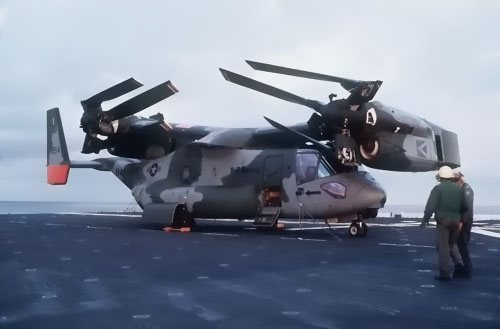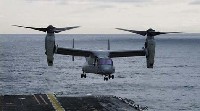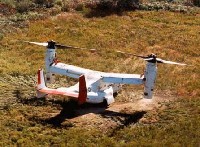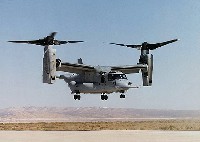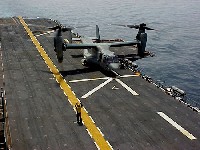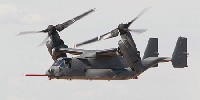|
Global Aircraft -- V-22 Osprey
Aviation Center
US Attack
US Bombers
US Cargo
US Fighters
US Helicopters
US Patrol/Pursuit
US Reconnaissance
US Tankers
US Trainers
US UAV's
US X Planes
Orbiter Vehicles
WWI Aircraft
WWII Aircraft
Airbus
Antonov
Boeing
Dassault
Ilyushin
Kamov
MiG
Mil
Saab
Sukhoi
Tupolev
Yakovlev
Joint/Rest of World
Entertainment Center
Members Center
New Technologies
Contact Us
Extra Navigation
GAC Engine
V-22 Osprey Specifications
V-22 Osprey Features
The Osprey is a tiltrotor aircraft with a 38-foot rotor system and engine/transmission nacelle mounted on each wing tip. It can operate as a helicopter when taking off and landing vertically. Once airborne, the nacelles rotate forward 90 degrees for horizontal flight, converting the V-22 to a high-speed, fuel-efficient turboprop airplane. The wing rotates for compact storage aboard ship. The first flight occurred in March 1989. The V-22 is the world's first production tiltrotor aircraft. Planned purchases include 360 for the Marine Corps, 48 for the Navy and 50 for the Air Force. Source: http://www.chinfo.navy.mil
V-22 Osprey Background
Bell Helicopter and Boeing Vertol joined forces during the early 1980s to develop a larger scale aircraft of the XV-15 tilt-rotor demonstrator program for the Joint Services Advanced Vertical Lift Aircraft program, which combined the vertical takeoff capabilities of a helicopter and the efficiencies of a fixed-wing aircraft. The V-22 was awarded with full-scale development in 1985. Flight testing of the V-22 started on March 19, 1989, and it successfully demonstrated airborne transition from helicopter to wing-borne flight in September 1989. Summary Copyright © Charles M (JetWhiz) | ||||||||||||||||||||||||||||||||||||||
